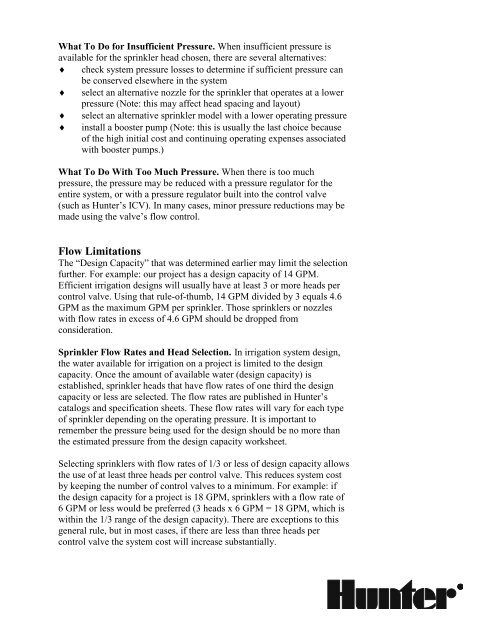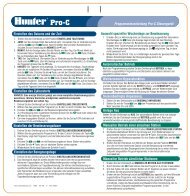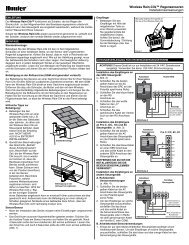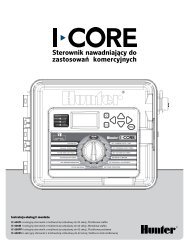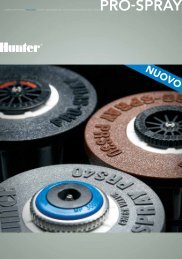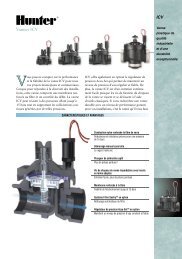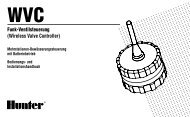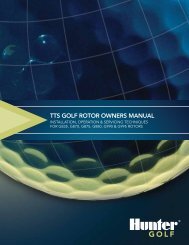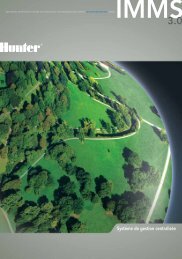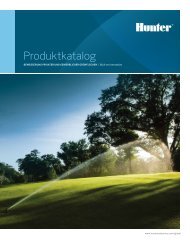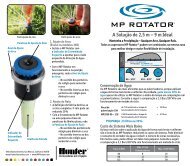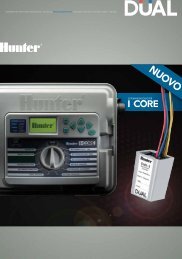Irrigation Professionals with questions about ... - Hunter Industries
Irrigation Professionals with questions about ... - Hunter Industries
Irrigation Professionals with questions about ... - Hunter Industries
Create successful ePaper yourself
Turn your PDF publications into a flip-book with our unique Google optimized e-Paper software.
What To Do for Insufficient Pressure. When insufficient pressure isavailable for the sprinkler head chosen, there are several alternatives: check system pressure losses to determine if sufficient pressure canbe conserved elsewhere in the system select an alternative nozzle for the sprinkler that operates at a lowerpressure (Note: this may affect head spacing and layout) select an alternative sprinkler model <strong>with</strong> a lower operating pressure install a booster pump (Note: this is usually the last choice becauseof the high initial cost and continuing operating expenses associated<strong>with</strong> booster pumps.)What To Do With Too Much Pressure. When there is too muchpressure, the pressure may be reduced <strong>with</strong> a pressure regulator for theentire system, or <strong>with</strong> a pressure regulator built into the control valve(such as <strong>Hunter</strong>’s ICV). In many cases, minor pressure reductions may bemade using the valve’s flow control.Flow LimitationsThe “Design Capacity” that was determined earlier may limit the selectionfurther. For example: our project has a design capacity of 14 GPM.Efficient irrigation designs will usually have at least 3 or more heads percontrol valve. Using that rule-of-thumb, 14 GPM divided by 3 equals 4.6GPM as the maximum GPM per sprinkler. Those sprinklers or nozzles<strong>with</strong> flow rates in excess of 4.6 GPM should be dropped fromconsideration.Sprinkler Flow Rates and Head Selection. In irrigation system design,the water available for irrigation on a project is limited to the designcapacity. Once the amount of available water (design capacity) isestablished, sprinkler heads that have flow rates of one third the designcapacity or less are selected. The flow rates are published in <strong>Hunter</strong>’scatalogs and specification sheets. These flow rates will vary for each typeof sprinkler depending on the operating pressure. It is important toremember the pressure being used for the design should be no more thanthe estimated pressure from the design capacity worksheet.Selecting sprinklers <strong>with</strong> flow rates of 1/3 or less of design capacity allowsthe use of at least three heads per control valve. This reduces system costby keeping the number of control valves to a minimum. For example: ifthe design capacity for a project is 18 GPM, sprinklers <strong>with</strong> a flow rate of6 GPM or less would be preferred (3 heads x 6 GPM = 18 GPM, which is<strong>with</strong>in the 1/3 range of the design capacity). There are exceptions to thisgeneral rule, but in most cases, if there are less than three heads percontrol valve the system cost will increase substantially.


